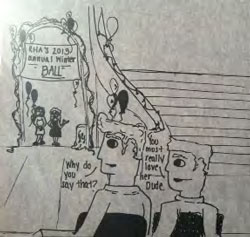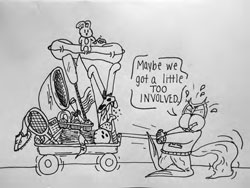When people think about adaptations, they might consider a feature film or TV series like Batman or True Blood respectively. Now, while comic books are generally about superheroes, they have also been used to adapt numerous stories to the four-colored world.
One of the earliest sets of graphic adaptations was with “Classics Illustrated,” which took famous works such as “The Odyssey,” “A Tale of Two Cities,” and even a comic book version of “Uncle Tom’s Cabin.” The “Classics Illustrated” series ran for three decades from 1941 to 1971. Through these comics, readers still experienced timeless classics but viewed them through a series of drawings by the artists involved.
Marvel Comics has continued the tradition of adapting classic stories for a modern audience with stories like “Moby Dick,” “Treasure Island,” and “Pride and Prejudice.” However, one of the more interesting aspects to revisiting old stories through comic book lenses is with the successful adaptations of L. Frank Baum’s Oz stories.
Together, writer Eric Shanover and artist Scottie Young have brought readers back to Oz through their illustrated versions of “The Wizard of Oz,” “The Marvelous Land of Oz,” and “Ozma of Oz.” While Shanover had previously brought other Oz stories to comics, this was the first he would work to stay true to the book.
In a 2008 interview with Marvel.com, Shanover described why he finally chose to adapt “The Wizard of Oz” for the House of Ideas. He said, “I wanted everything that was part of the book to stay in some way. Now, of course, it’s an adaptation, and it’s for a different medium from prose to comics, so there are different demands. My other main goal was to make sure it was a good comic, not just an adaptation where it didn’t matter to me if it was good or bad as long as I got everything in.”
Shanover and Young will continue their collaboration down the yellow brick road with the next series “Dorothy & the Wizard of Oz.”
While Marvel has had its hands busy retelling timeless stories, they haven’t been the only ones to do so. Companies like IDW have demonstrated their adaptations through graphic novels like “I Am Legend” and using fan-favorite horror writer, Steve Niles, to help guide the artist’s vision to this apocalyptic tale.
One of the larger adaptations developed is the 24-part series for “Do Androids Dream of Electric Sheep,” based on the novel by Philip K. Dick, written by Warren Ellis, and illustrated by Tony Parker. The series followed the novel about android bounty hunter a.k.a Blade Runner Rick Deckard, who is tasked with eliminating androids hiding out on Earth. (This story was the basis for Ridley Scott’s Blade Runner film).
When Chad Nevett of Comicbookresources reviewed “Do Androids Dream of Electric Sheep” #1, he gave the issue a four out of five rating. “Even though BOOM! hasn’t changed or omitted a single word from Dick’s novel, this is a very different experience from reading the novel. That said, what a wonderful idea and fantastic way to introduce the work of Philip K. Dick to new readers. With the huge influence Dick has had on sci-fi and comics, his work should be mandatory reading for anyone who regularly engages either,” he wrote.
While classic novels of the past and recent past are ripe for transitioning to comic books, that doesn’t mean recent stories or ongoing tales can’t be presented as well.
Recently, Dark Horse Comics announced that they would be taking the vampire novel “The Strain,” by Guillermo Del Toro and Christopher Golden, and bringing undead to the comic book world. Helping these writers move their tale from paragraphs to panels will be David Lapham, who has written comics like “The Darkness” as well as film adaptations like Predator. Mike Huddleston will handle the artwork.
Some exciting bit of news in the last few months was how George R. R. Martin’s “A Game of Thrones” would be venturing into the comic book realm of comics courtesy of Dynamite Entertainment. Daniel Abraham will be scripting the series based on the novel while artist Tommy Patterson will illustrate Martin’s world. The novel was terrifically presented in live-action HBO series, Game of Thrones, so observing it in another new medium will make the adventure exciting once more.
In an interview with geek-news.mtv, Abraham described the process of telling his version of this fantasy epic following the success of the HBO series.
Abraham said, “By the time the series came out, I was already several issues into the scripting of the comic, and a lot of my own decisions for how to approach it were set. I paid attention to the series in the sense of watching what someone else came up with when they moved to a visual medium, but I’m not adapting the HBO show. I’m adapting the book.”
Look for “Game of Thrones” #1 in stores today.
These and other examples out there show that good stories cannot just be contained to one medium. They can branch out to other art forms, whether movies, TV, or comics, and take a fresh approach to an old or new tale for fans all around.




